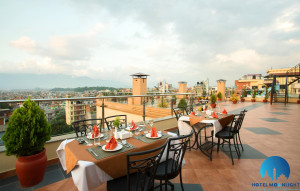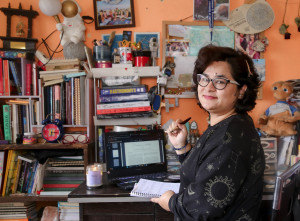Culture & Lifestyle
Funny or offensive? The debate that never ends in stand-up
As Kathmandu’s stand-up comedy scene grows, comedians face mixed reactions from live and online audiences.
Sanskriti Pokharel
In 2015, Biswas Timshina made his stand-up comedy debut in New Delhi, India, when the country’s comedy scene was gaining momentum. While his performance was well-received, Timshina was worried when he witnessed an audience member clash with a comedian. This unsettling experience made him reconsider starting in New Delhi.
Timshina then moved to Mumbai, where he found the audience less aggressive than New Delhi’s. After a few shows, he returned to his hometown, Sikkim. Unfortunately, his team struggled to sustain open mic sessions due to the smaller crowd. Eventually, Kathmandu became his true calling. “The capital was in the sweet spot of a good population and thriving community,” says Timshina.
“Since 2017, stand-up comedy in Kathmandu has surged to a new height, with new talents coming to the spotlight,” says Aayush Shrestha, a stand-up comedian.
“At times, we talk about the country and the world, while other times, even small things like a book or a wall become the focus of our comedy. Some things may not seem funny, but making them sound funny is part of our job,” Shrestha adds.
It’s a common misconception that every idea comedians jot down will automatically be funny. In reality, they take the stage to test their material, observe audience reactions, and refine their jokes based on the feedback they receive. Comedians who excel at spontaneous humour and can generate laughs on the spot have honed their skills through extensive practice. Over time, they develop an understanding of what triggers laughter.
As Shrestha explains, “There’s no single method for generating ideas. Sometimes inspiration strikes when you observe something, which becomes your material; other times, a joke may come to you all at once. Occasionally, you need to sit down with pen and paper to brainstorm new concepts.”
Apoorwa Kshitiz reflects on the audience dynamics before the pandemic, saying, “Before Covid-19, we had many attendees. We often held two shows a day, with tickets priced at five hundred rupees. Even when we sold out, the demand was still high. This interest likely came from the growing popularity of stand-up comedy, as people were eager to experience it.”
“We are experimenting with new show formats to draw in more audiences. Apart from standup, we are also conducting double headliner shows.” (A double headliner show is a live event where two main acts or performers headline the show).
Conversely, Yozana Thapa Magar believes the stand-up comedy scene has reached new heights post-pandemic. She asserts, “I feel that now we are at our peak. The stand-up comedy environment is significantly better than before the pandemic.” Alan Jung Thapa adds, “Sometimes the turnout is so overwhelming that it surprises me.”
Furthermore, Magar says, “Before the pandemic, many groups organised simultaneous stand-up events, but the quality often fell short. Now, we have improved setups and systems. The technology we use has been tested and refined. Performers are better prepared, and we’ve grown as comedians, gaining confidence. We also have a loyal audience base. Many who enjoyed our performances in the past now regularly attend our shows.”

Stand-up comedy shows are organised at various venues in Kathmandu. Suman Bhattarai, co-founder and managing director of Takshak Entertainment (the company organises stand-up shows), explains, “We don’t have a fixed venue for our shows. We carefully consider the feasibility of each venue, including its terms and conditions, ambience, and more. We also secure sponsors for our events. Some venues even reach out to us to host our shows. When choosing a venue, we prioritise a cosy, spacious environment where one person laughing loudly won't disturb others, good stage lighting, high-quality sound, and minimal distractions."
In the past, comedians would arrive at venues three to four hours before the performance. They had to ensure everything was in place, from the settings and systems to the sound.
Thapa says, “Now, we no longer have to worry about anything except our performance. With everything else taken care of, we can simply arrive at the venue and perform. The stand-up comedy scene in Kathmandu is much more professional now.” However, Kshitiz, a chartered accountant, and Shrestha, a software engineer, agree that sustaining a livelihood solely through stand-up comedy is insufficient.
Shrestha says, “The only way we get paid is through ticket sales. Unfortunately, our viewers haven’t developed a habit of buying tickets to laugh yet.” Therefore, despite millions of views on YouTube and reels, comedians earn money primarily through live audiences who purchase show tickets.
Shrestha says, “We focus more on live audiences than online ones. We only pay attention to online audiences to stay relevant. But once our live performance goes online, the worst side of people often comes out in the comments section.”
In his seven years of stand-up comedy, Shrestha has found that live shows are mostly fun, with few to no issues. Rarely does anyone get offended; if they do, it’s resolved quickly without causing further problems. However, once the same performance goes online, Shrestha notices the difference between live and online audiences.
Thapa says, “We need to distinguish who our audiences are and who are not. Those who scold us in the comment sections are not our audiences because they never come to our shows or any comedy shows.” As a result, after the video goes online, some individuals get offended, and the negativity comes out.
So, how do we draw a line between what is offensive and what is funny?
Shrestha says, “What is funny and what is offensive is a subjective thing. We cannot draw a line between them. It’s weird to have that distinction.”
Kshitiz explains, “Comedians never aim to offend their audience. We intend to make you laugh, but sometimes it doesn’t land that way. If there were a clear boundary between offensive and funny, we would gladly follow it. It would leave no room for questions or negative feedback.”
Interestingly, the topics people hesitate to discuss openly—like sex—often sell the most tickets and spark the greatest reactions. This paradox highlights a truth: comedians don’t draw the line between what is funny and offensive; individual perspectives and societal norms shape them.




 13.12°C Kathmandu
13.12°C Kathmandu















